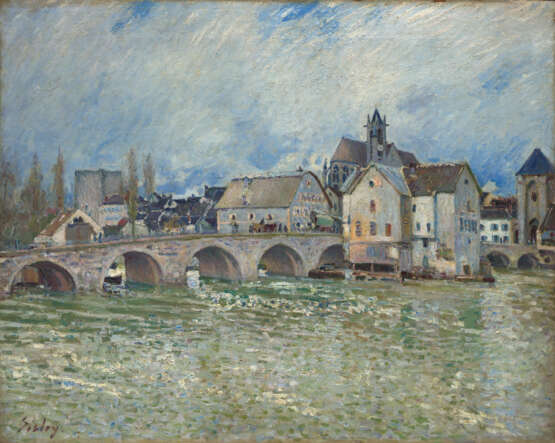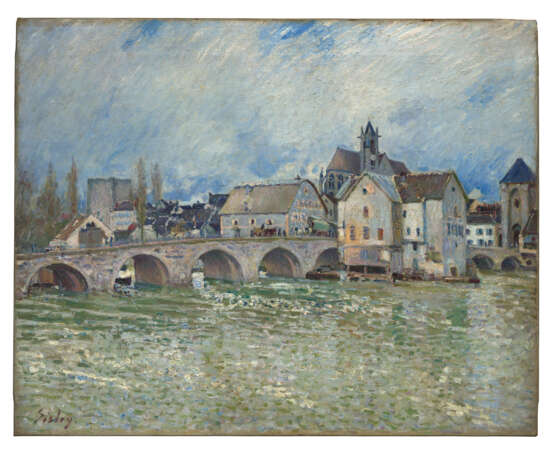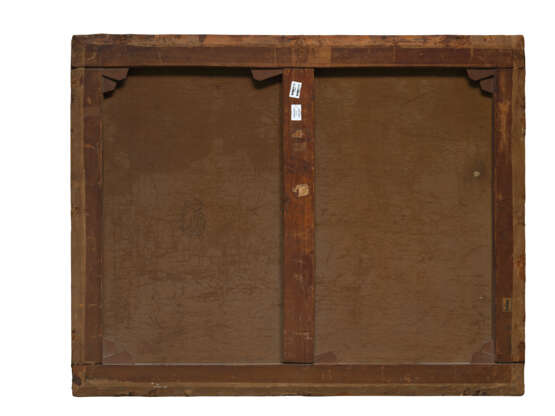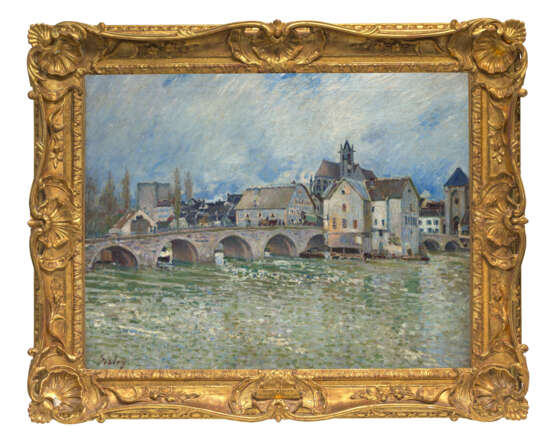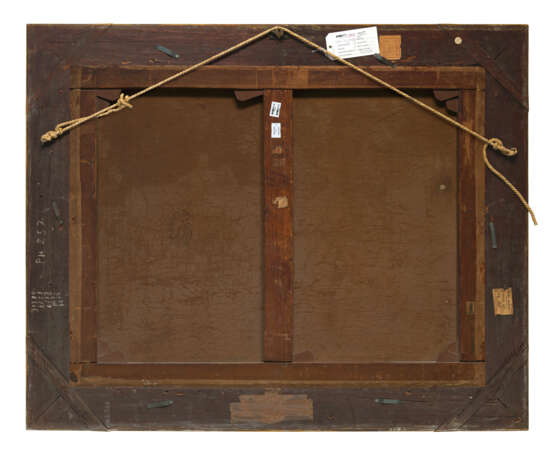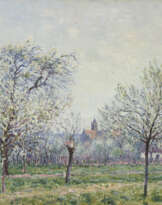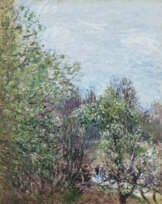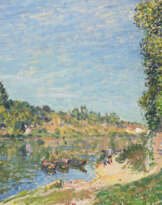ID 1177510
Lot 11 | Alfred Sisley (1839-1899)
Estimate value
€ 500 000 – 800 000
Le Pont de Moret-sur-Loing, temps de crue
signé 'Sisley.' (en bas à gauche)
huile sur toile
73.9 x 92.6 cm.
Peint vers 1889
signed 'Sisley.' (lower left)
oil on canvas
29 x 36 3⁄8 in.
Painted circa 1889
Provenance
Isidore Montaignac, Paris (avant 1897).
Charles Viguier, Paris; sa vente, Me Chevallier, Paris, 4 mai 1906, lot 62.
Isidore Montaignac, Paris; sa vente (annulée), Mes Baudoin, Dubourg, Lair-Dubreuil et Mauger, Paris, 3 décembre 1917, lot 82.
Wilhelm Hansen, Copenhague (acquis auprès de celui-ci par l'intermédiaire de Monsieur Duval-Fleury en décembre 1917).
Collection Salomon, Copenhague.
S.A.R. la Maharanée de Baroda, Paris; sa vente, Palais Galliera, Paris, 30 novembre 1961, lot 16.
Huguette Berès, Paris.
Commandant Paul-Louis Weiller, Paris.
Puis par descendance au propriétaire actuel.
Literature
F. Daulte, Alfred Sisley, Catalogue raisonné de l'œuvre peint, Lausanne, 1959, no. 701 (illustré).
S. Brame et F. Lorenceau, Alfred Sisley, Catalogue critique des peintures et des pastels, Lausanne et Paris, 2021, p. 294 et 487, no. 782 (illustré en couleurs, p. 294 et 487).
Exhibited
Paris, Galeries Georges Petit, Exposition Alfred Sisley, février 1897, no. 31 (daté '1888').
Paris, Galeries Georges Petit, Exposition d'œuvres de Alfred Sisley, mai-juin 1917, no. 12.
Further details
« …devant cette nature si touffue, ces grands peupliers, cette eau du Loing si belle, si transparente, si changeante, c’est à Moret certainement que j’ai fait le plus de progrès dans mon art ; surtout depuis trois ans. Aussi, quoiqu’il soit bien dans mes intentions d’agrandir mon champ d’études, je ne quitterai jamais complètement ce coin si pittoresque. »
Alfred Silsey, cité dans Alfred Sisley, Poète de l’impressionnisme, cat. exp. Musée des Beaux-Arts, Lyon, 2002-2003.
Par ces mots, Sisley exprime tout l’attachement qu’il porte au village médiéval de Moret-sur-Loing où il est installé depuis 1880. Parmi les endroits et points de vue qui l’ont le plus inspiré, le pont qui enjambe le Loing fait certainement partie des sujets de prédilection de cet impressionniste convaincu. Au-delà de l’architecture du pont et de la ville, c’est la vie qui s’y déroule qui le captive particulièrement. Dans Le Pont de Moret-sur-Loing, temps de crue, le dynamisme de la scène peut se découper en trois parties : le ciel orageux, l’activité humaine sur le pont et le Loing agité. Par de rapides coups de pinceaux blanc sur un ciel bleu, le peintre renforce l’aspect tumultueux de la scène, tout en ne faisant l'économie de matière. Sur la partie centrale on devine, à partir des formes aux couleurs chaudes tracées lestement, que les habitants se hâtent de rentrer avant la pluie. Sur le fleuve occupant la partie inférieure de la toile, les petites touches de peinture se heurtent à des traits de pinceaux plus étalés afin de rendre compte de l’affolement de l’eau qui se creuse en vaguelettes et qui s'agite à cause de l'ondée qui arrive. La centralisation des figures humaines dans le tableau, entourées, presque écrasées entre le ciel et le fleuve, avive cette atmosphère menaçante et orageuse.
Thème cher à Sisley, le pont de Moret-sur-Loing est également le sujet principal d'une œuvre conservée au Musée d’Orsay. Peint en 1893, ce tableau, intitulé Le Pont de Moret reflète l’adage « après la pluie, le beau temps » : contrairement à la présente œuvre l'artiste y dépeint un ciel d’un beau cyan, dégagé, et une scène baignée de soleil, où se déroule une activité bien plus paisible et routinière.
Bien que discret dans le groupe des impressionnistes, Alfred Sisley fait évoluer le mouvement par son travail des émotions, rendues par une touche plus ou moins rapide, plus ou moins texturée. Toute la poésie du peintre se niche dans ces paysages modestes qui lui permettent de faire le lien entre art et nature et qu’il ne retranscrit pas avec dramatisme et excès, mais avec harmonie et nuances subtiles. Comme Silsey l'afirma lui-même, « la vie et le mouvement sont nécessaires, ils dépendent de l'émotion de l'artiste, qui doit modifier sa facture selon cette émotion... ».
"...in front of this nature so dense, these large poplars, this water of Loing so beautiful, so transparent, so changing, it is in Moret certainly that I made most progress in my art; especially since three years. So, although I intend to expand my field of study, I will never completely leave this picturesque spot.
Alfred Silsey, quoted in Alfred Sisley, Poète de l'impressionnisme, cat. exp. Musée des Beaux-Arts, Lyon, 2002-2003.
With these words, Sisley expressed his attachment to the medieval village of Moret-sur-Loing, where he had lived since 1880. Among the places and viewpoints that most inspired him, the bridge spanning the Loing was certainly one of the favourite subjects of this committed Impressionist. Beyond the architecture of the bridge and the town, it was the life that took place there that particularly captivated him. In Le Pont de Moret-sur-Loing, temps de crue, the dynamism of the scene can be broken down into three parts: the stormy sky, human activity on the bridge and the turbulent Loing. With rapid brushstrokes of white against a blue sky, the painter reinforces the tumultuous aspect of the scene, while sparing no material. In the central part of the painting, we can tell from the warmly coloured shapes that the inhabitants are hurrying home before the rain. On the river occupying the lower part of the canvas, the small dabs of paint clash with more spread-out brushstrokes to convey the panic of the water as it deepens into ripples and becomes agitated by the oncoming downpour. The centralisation of the human figures in the painting, surrounded, almost crushed between the sky and the river, heightens this threatening, stormy atmosphere.
A theme dear to Sisley, the bridge at Moret-sur-Loing is also the main subject of a work in the Musée d'Orsay. Painted in 1893, this painting, entitled Le Pont de Moret, reflects the adage "after the rain, the fine weather": unlike the present work, the artist depicts a clear cyan sky and a scene bathed in sunlight, where activity is much more peaceful and routine.Although a discreet member of the Impressionist group, Alfred Sisley developed the movement through his work on emotions, rendered by a more or less rapid, more or less textured brushstroke. All the painter's poetry nestled in these modest landscapes, which enabled him to make the link between art and nature, and which he did not transcribe with drama and excess, but with harmony and subtle nuances. As Silsey himself said, "Life and movement are necessary, they depend on the emotion of the artist, who must modify his work according to this emotion...".
| Artist: | Alfred Sisley (1839 - 1899) |
|---|---|
| Applied technique: | Oil on canvas |
| Genre: | Cityscape |
| Auction house category: | Paintings, Watercolors, Drawings, Paintings |
| Artist: | Alfred Sisley (1839 - 1899) |
|---|---|
| Applied technique: | Oil on canvas |
| Genre: | Cityscape |
| Auction house category: | Paintings, Watercolors, Drawings, Paintings |
| Address of auction |
CHRISTIE'S 9 Avenue Matignon 75008 Paris France | ||||||||||||||
|---|---|---|---|---|---|---|---|---|---|---|---|---|---|---|---|
| Preview |
| ||||||||||||||
| Phone | +33 (0)1 40 76 85 85 | ||||||||||||||
| Fax | +33 (0)1 40 76 85 86 | ||||||||||||||
| Conditions of purchase | Conditions of purchase | ||||||||||||||
| Shipping |
Postal service Courier service pickup by yourself | ||||||||||||||
| Payment methods |
Wire Transfer | ||||||||||||||
| Business hours | Business hours
|
